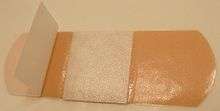Band-Aid
Band-Aid is a brand of adhesive bandages distributed by the American pharmaceutical and medical-devices company Johnson & Johnson. Invented in 1920, the brand has become a generic term for adhesive bandages in the United States, Canada, and Australia.
  | |
| Product type | Adhesive bandage/dressing |
|---|---|
| Owner | Johnson & Johnson |
| Country | U.S. |
| Introduced | June 1920 (invention) |
| Markets | Worldwide |
| Tagline | "I am stuck on Band-Aid (brand) 'cause Band-Aid's stuck on me!" |
| Website | www |

History
The Band-Aid was invented in 1920 by a Johnson & Johnson employee, Earle Dickson in Highland Park, New Jersey[1] for his wife Josephine, who frequently cut and burned herself while cooking.[2] The prototype allowed her to dress her wounds without assistance. Dickson passed the idea on to his employer, which went on to produce and market the product as the Band-Aid. Dickson had a successful career at Johnson & Johnson, rising to vice president before his retirement in 1957. Perhaps a curiosity, the word "Band" in German means tape.
The original Band-Aids were handmade and not very popular. By 1924, Johnson & Johnson introduced machine-made Band-Aids and began the sale of sterilized Band-Aids in 1939.[3]
In 1951, the first decorative Band-Aids were introduced. They continue to be a commercial success, with such themes as Mickey Mouse, Donald Duck, Oliver & Company, Superman, Spider-Man, Rocket Power, Rugrats, smiley faces, Barbie, Dora the Explorer, Batman and Duck Dynasty.
In World War II, millions were shipped overseas, helping popularize the product. Since then, Johnson & Johnson currently has estimated a sale of over 100 billion Band-Aids worldwide.[4]
Trademark status
Band-Aid has, over time, become a well-known example of a genericized trademark in the United States, but Johnson & Johnson has registered Band-Aid as a trademark on the Principal Register of the United States Patent and Trademark Office and the registration is valid and legal.[5] Johnson & Johnson continues to defend the Band-Aid trademark against it being genericized.[6]
To protect the name, their trademark, Johnson & Johnson always refers to its products as "BAND-AID® Brand Adhesive Bandages", not just "Band-Aid".
See also
- Elastoplast, a comparable European brand and genericized trademark
References
- "Historical timeline". hphistory.org. Retrieved 2018-06-02.
- "BAND-AID® Brand Heritage". Johnson & Johnson. April 2015. Archived from the original on June 15, 2013. Retrieved September 21, 2015.
- "The History of the Band-Aid". Retrieved 25 August 2018.
- "The Story of the Black Band-Aid". 2013-06-06. Retrieved 25 August 2018.
- "Trademark Status & Document Retrieval: BAND-AID". USPTO. May 15, 2012. Retrieved September 21, 2015.
- "Practical Tips on Avoiding Genericide". www.inta.org.
External links
| Look up band-aid in Wiktionary, the free dictionary. |